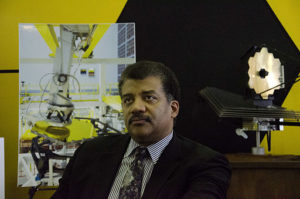
Image: Dr. Neil deGrasse Tyson visited with Goddard’s Space Flight Center Director Chris Scolese and the James Webb Space Telescope team at Goddard in Greenbelt, Md. on June 3, 2014. Tyson spoke to the team and was able to see the giant vacuum test chamber that now holds the heart of the telescope, the Integrated Science Instrument Module.
Photo attribution: By NASA Goddard Space Flight Center from Greenbelt, MD, USA (Dr. Neil deGrasse Tyson Visits NASA Goddard) [CC BY 2.0 (http://creativecommons.org/licenses/by/2.0)], via Wikimedia Commons
If you haven’t heard Neil deGrasse Tyson speak about science, you’ll be spellbound when you watch his illustrated narration of “A brief History of Everything.” (If that title sounds familiar, that’s because it harkens back to Stephen Hawking’s classic explanation of theoretical physics concepts related to time, for the non-scientist, “A Brief History of Time.”)
VIDEO, 8 min. 30 sec.
The astrophysicist, Neil deGrasse Tyson, who is head of the Hayden Planetarium and host of “Space Talk” on the National Geographic channel, has been much in the news lately, one timely news event being his commentary on inventions in the movie, Back to Future, which movie was celebrated on October 21, 2015, the date that actors Michael J. Fox and Christopher Lloyd (the scientist) traveled to, in “Back to Future 2,” the movie.
Why Nurture Science and Technology?
Innovations in science and technology “are the engines” of the economy of the future, said astrophysicist Neil deGrasse Tyson.
“Anything that’s going to grow in our economy will derive from innovations in STEM fields,” Tyson told CNBC in an interview this week, using the acronym for the fields of science, technology, engineering and math.
Tyson is a big believer in how science and technology have the potential to boost economic growth. In a separate interview earlier this year with CNBC’s “On the Money,” the scientist predicted the world’s first trillionaire would be created in outer space.
. . . . Tyson is the head of the world-renowned Hayden Planetarium in New York City. He also hosts “Space Talk” on the National Geographic Channel, where he aims to relate the wonders of the universe to the everyday lives of his viewers, including the arcana of football.
Could the earth’s rotation influence a football bounce-off?
On Sunday afternoon in Week 5 of the National Football League’s regular season, he took to Twitter to explain how Cincinnati’s winning overtime field goal managed to bounce in off the upright.
“I said, ‘Wait a minute. [Let’s] check some calculations.’ And sure enough, it was aided by a one-third of an inch drift from Earth’s rotation. So yeah, Earth’s rotation enabled that win,” Tyson told “Squawk Box” Friday.
Source: © 2015 Twentieth Century Fox Film CorporationTyson made his case using a baseball analogy.
“If you have a curved surface bouncing against curved surface, as any baseball player knows who has a curved bat and a round ball, a fraction of an inch is the difference between a pop up, a home run or a ground out,” he said.
Tyson found 2 non-human movie stars in “The Martian”
Tyson also discussed the science in “The Martian,” the new movie starring Matt Damon, in which his character is left behind on the red planet. Since its Oct. 2 debut, the movie has grossed nearly $150 million.
“I think it was the first movie ever where science and engineering are themselves characters,” Tyson said.
“They’re responsible for the suspense, the joy, the misery, what makes people anxious — all of these things that are normally the interplay of human emotion, flow through whether or not science and technology problems get solved,” he added. “It succeeded in this. It was brilliantly done.”
Tyson analyzed what Back to Future 2 inventions materialized by 2015
. . . . Tyson was also tweeting on Wednesday’s celebration of “Back to the Future” Day; Oct. 21, 2015, was the date that Marty McFly and company journeyed 30 years ahead to, in the time-traveling trilogy’s second installment.
Depicting life in 2015, the movie “Back to the Future 2,” released in 1985, got some things right, such as fingerprint scanners, but others really wrong, like flying cars. Below are some of the highlights of Tyson’s scorecard.
Here’s the “Back to Future” moment that told us the date.
Before you visit the source article, and just in case you missed this trailer from the 1985 film, Back to Future 2, you’ll find the reference to October 21, 2015 in this short video clip.
Please see the source article, here, to see Tyson’s scorecard on what predictions the classic 1985 film, Back to Future, got right.
For a 22-minute video of some of Tyson’s most entertaining moments (you can at least catch one or two if you don’t have 22 minutes), visit the video on the next page.



